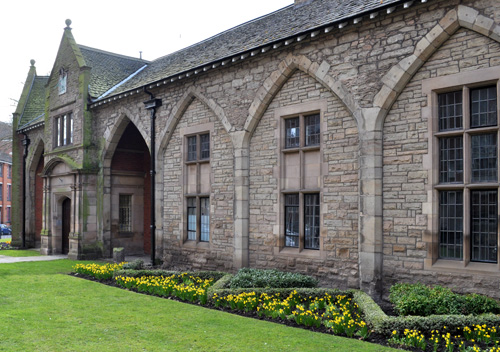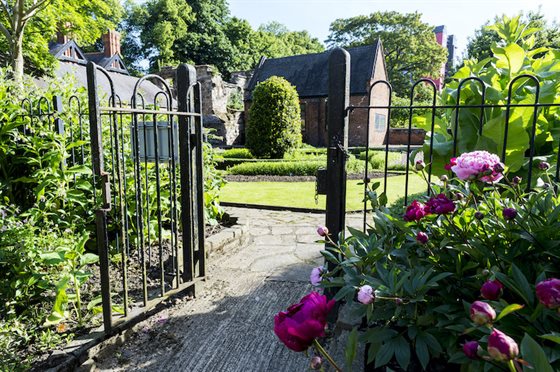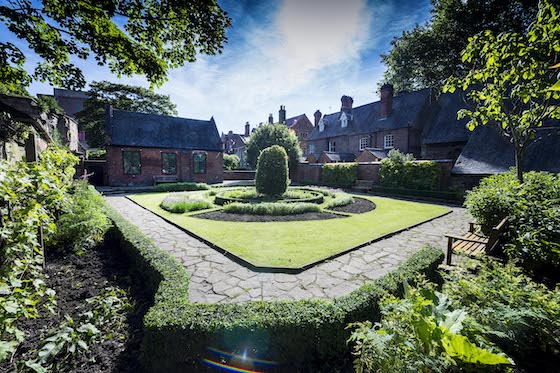DMU’s campus sits on one of the oldest parts of the city. Trinity Hospital, founded in 1330 to care for the poor and infirm, is now university offices. But a part of the past which still exists today is the herb garden. Once a vital source of medicine for the hospital nurses, the garden now provides fresh herbs and heritage varieties for students, staff and the public who visit the Riverside Café. As part of DMU’s 150th anniversary celebrations, we look at the story behind the garden through the centuries.
Trinity Hospital was founded in 1330 to provide long-term care to 50 poor and infirm people of Leicester. At this time, hospitals were founded by wealthy benefactors keen to ease their own passage to Heaven and Henry, third Earl of Leicester, would certainly be hoping this good work would gain him favour in the afterlife.
Henry died in 1345 and his funeral, held in the hospital chapel, was attended by King Edward III and his wife, Philippa of Hainault. Henry’s son, also named Henry, expanded the hospital so that it could take 100 patients. On his death in 1361 the estates passed to his daughter, Blanche, who was married to the powerful John of Gaunt. When John and Blanche’s son Henry Bolingbroke became King Henry IV the Duchy of Lancaster passed into Royal hands, as did the patronage of the hospital. To this day the Duchy pays money every year towards its upkeep.
What was the hospital like?If you were a patient in Trinity Hospital, you would have a bed in its 200ft long hall, in view of the chapel altar. The sum of 1p a day was allowed per person for their care. The health of the resident’s soul was just as important as their physical health – so, while herbal remedies from the garden treated their physical ailments, their spiritual health was taken care of by regular mass and confession.
A religious precinct, a Newarke or ‘New Work’ was built around the hospital and was home to a college of priests as well as the Church of the Annunciation of the Blessed Virgin Mary, which stood roughly where Hawthorn Building does today.
Medieval MedicineDuring the Middle Ages, medicine was based on the idea that the body had four ‘humours’ which related to four elements. It was thought that if you were ill, then it was because you were out of balance and had too little or too much of one or more of the elements.
Blood (air) was hot and moist
Phlegm (water) was cold and moist
Yellow Bile (fire) was hot and dry
Black Bile (earth) was cold and dry
In medieval times, they believed different herbs had different properties that would help restore balance – so a herb thought to ‘cool’ would be used to counter an excess of blood, for example.
 Medieval Herb Gardens
Medieval Herb Gardens Another weapon in the fight against disease was the herb garden, the word drug literally means dried plant.
The typical garden would consist of raised rectangular beds with wicker fencing, forming a chess-like grid pattern with walkways between – wealthier monasteries may have used the decorative herb wheel. Raised beds allow for easier weeding and the soil to be well-drained, as many herbs prefer free draining soil.
Herbs would be administered based on their observed properties. In medieval times, people believed that plants gave ‘clues’ to their properties in what they looked like, a belief called the Doctrine of Signatures. For example, viper’s bugloss got its name because its baby leaves look like snake’s tongues – and so it was thought to treat snakebite. (spoiler alert: it doesn’t).
Herbs did not only provide a medicinal use, diet was considered to have important influence on health – the ancient Greek Hippocrates famously stated ‘Let food be thy medicine and medicine be thy food’, to put it simply; eat well to stay well.
 What did people grow in their herb gardens?
What did people grow in their herb gardens?The typical plants grown in a medieval almshouse such as the Trinity Hospital would include many we recognise.
The garden was not just the Middle Ages’ medicine cabinet but a space where the mind could be healed. Sight and smell were valued in medieval physicians’ treatments. Bad smells were thought to carry disease whereas floral fragrances purified the air and lush landscapes promoted good health and mental wellbeing.
Strewing herbs such as Lady’s Bedstraw were grown to be cut and brought into the house to be put on the floors and disguise odours along with lavenders. They would release their scent when crushed underfoot.
Roses were grown for their scent and used in posies, which were carried and sniffed throughout the day along with lavenders, southernwood, sages and mints.
The medieval plot would contain herbs like Bay Laurel, sage, fennel, thyme, dill, winter savoury and rosemary for cooking and use in herbal remedies.
Less familiar herbs such as rue, agrimony, marsh mallow and tansy were also found in the Middle Ages, along with plants grown for their colour such as dyers’ chamomile or woad.
 THE HERB GARDEN TODAY
THE HERB GARDEN TODAYA restoration of the herb garden was carried out by heritage gardener Dan Kirk at DMU. Using heritage varieties of vegetables and herbs, he has re-created a traditional herb wheel planting design, with fruit trees trained against the brick walls, and a lavender hedge proving a magnet for bees and butterflies.
In the beds are herbs and vegetables including:
• Red Perilla shiso ,
• Liquorice Mint Agastache
• Coriander
• Fennel
• Dill
• Lovage
• Sweet Cicely – add a leaf to cooking fruit and you only need to use half the sugar
• Peruvian black mint
• Chives
• Spearmint
• Thyme
• Parsley
Dan works with the chefs at Chartwells who visit the garden during term time to harvest the herbs – they’ve calculated it takes just 139 steps from the garden to the kitchen. You’ll find herbs used in sauces, salad dressings, pesto, purees and more if you visit The Riverside Café.
Seeds are sourced from The Real Seed Company, which produce heritage and heirloom varieties specifically for the kitchen garden.
The herb garden is also used for mindfulness sessions, to improve student and staff wellbeing – much like it was used hundreds of years ago as a space for calm and peace in medieval times.
* Have you been inspired to grow your own herb garden?
check out our PDF guide here
Posted on Wednesday 15 July 2020